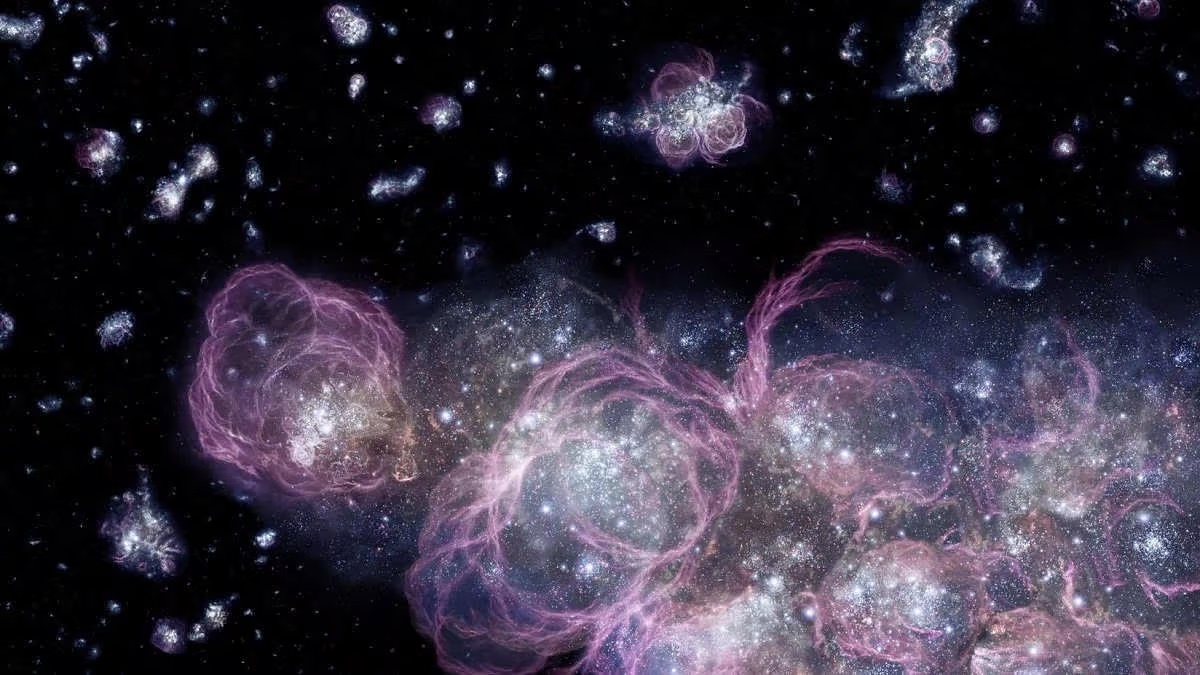20.07.2023

Artist's impression of star formation in the early universe. Credit: NASA and K. Lanzetta (SUNY). Artwork: Adolf Schaller for STScI.
James Webb Space Telescope (JWST) discoveries of highly evolved galaxies only 325 million years after the Big Bang is expected to have occurred has driven one cosmologist to a radical new theory: the universe is much older than we think.
Current estimates place the Big Bang 13.8 billion years ago. University of Ottawa adjunct professor Rajendra Gupta has calculated that it is, in fact, 26.7 billion years old – nearly twice as old as the current accepted model.
But experts warn us to be cautious: “Extraordinary claims require extraordinary evidence,” says one cosmologist.
How old do you think I am?
Guessing the age of things is difficult at the best of times.
Tree rings can tell you the age of trees that have grown in temperate climates. Radioisotope analysis can give a relatively accurate picture of how old certain fossils or rocks are on Earth. But determining the age of the universe is a completely different matter.
How did cosmologists come to calculate the universe’s age as 13.8 billion years old in the first place?
“Our best estimates for the age of the universe are based on observations of the cosmic microwave background radiation (CMB) and measurements of the universe’s expansion through Hubble’s Law,” says Dr Michael Cowley from the Queensland University of Technology told Cosmos.

The cosmic microwave background, as imaged by the European Space Agency’s Planck satellite, from which measurements of the early universe’s rate of expansion were derived. Credit: NASA/SCIENCE PHOTO LIBRARY
CMB is relic radiation from the Big Bang dating back to just 300,000 years after the universe was born. It permeates the universe and is the earliest observable radiation in the cosmos. Cowley explains that a complicated process of analysing temperature fluctuations in the CMB allows cosmologists to determine the age of the universe.
Hubble’s Law, Cowley explains, was established by astronomer Edwin Hubble in the 1920s. It relates the distances and velocities of galaxies and helps determine the rate of the universe’s expansion, called the Hubble constant.
“By extrapolating this expansion backward, we can estimate the time of the Big Bang,” Cowley says.
Tired photons
Gupta’s new model, described in a paper published in the Monthly Notices of the Royal Astronomical Society takes a completely different approach.
A theory, known as “tired light” (first suggested by physicist Fritz Zwicky in 1929) is employed to explain the redshifting of photons from distant galaxies. In current cosmology, redshift is the stretching of photons caused by the expansion of the universe, akin to the experience we have when an ambulance siren drops in pitch as it drives away from the listener.
Tired light theory suggests that photons gradually lose energy over cosmic distances. Though it conflicts with observations, Gupta says that “by allowing this theory to coexist with the expanding universe, it becomes possible to reinterpret the redshift as a hybrid phenomenon, rather than purely due to expansion.”
A galactic problem, or not?
The existence of galaxies in the first few million years of the universe is sometimes referred to as the “impossible early galaxy problem.”
Gupta also introduces new physical constants that change over time, extending the existence of early galaxies in the universe from the first few hundred million years of the cosmos to several billion years, helping him to conclude the universe may actually be nearly 28bn years old. .
Cowley says estimates of the age of the universe are challenged by physics and observation.
“Our current understanding of the universe suggests galaxies take time to develop, by accumulating stars and building structures through various processes,” Cowley explains. “However, new observations with cutting-edge telescopes (like the JWST) have revealed mature galaxies at a time when the universe was relatively young. Their existence challenges our current understanding of how galaxies form and evolve over cosmic time.”
A much simpler explanation for the existence of these galaxies may just be that we don’t fully understand galactic evolution in the early universe.
“‘Impossible’ is far too strong,” says Dr Luke Barnes from Western Sydney University, who believes Gupta is probably wrong. “We have unanswered questions about how galaxies could have formed as early as we see them in JWST observations. But nothing about the situation is impossible.”
Professor Tamara Davis from the University of Queensland agrees.
“There was an initial burst of excitement over seeing so many early galaxies from JWST, which is exactly what we’d hoped JWST would see,” Davis says. “It is a bit of a puzzle of how exactly do those structures form.”
Cosmologists not yet convinced
Experts don’t believe Gupta’s theory is going to cause a paradigm shift in cosmology any time soon.
“Our current model of the Big Bang and the expansion of the universe is supported by a wealth of observational evidence and has explained various cosmological phenomena,” Cowley says. “For this new research to gain traction, I believe further research and theoretical developments would be required.”
Davis points out that the Standard Model of Cosmology which states the Big Bang occurred about 13.8 billion years ago has used measurements “through a combination of a whole bunch of different probes.” These include analysing data from supernovae, galaxy distribution and measurement of the universe’s expansion.
Gupta’s paper, on the other hand, “only considers supernova data, which these days is really just a no-no,” Davis says. “Extraordinary claims require extraordinary evidence. You have to go and test it, and test it in different ways.”
While Gupta’s new theory has received much attention in the media, Barnes puts this down to “irresponsible hype,” and questions the science behind the paper.
Barnes adds that “there is a basic set of cosmological observations that any contender for the Big Bang’s title needs to explain. That’s how your new theory buys its ticket. Solving a new puzzle doesn’t count for much if we don’t know whether it can explain established data.”
Quelle: COSMOS
